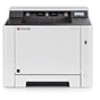Kyocera ECOSYS P5021cdw ECOSYS M5526/M5521/P5021/P5026 Series Printer Driver U - Page 62
Selecting Print Quality, Trapping, Setting Trapping Values, Font Settings
 |
View all Kyocera ECOSYS P5021cdw manuals
Add to My Manuals
Save this manual to your list of manuals |
Page 62 highlights
Imaging Selecting Print Quality 1 In Imaging > Print Quality, select a print quality from the list. 2 Select: Custom You can select EcoPrint. Custom > Custom Quality Settings You can set the Resolution. For both of these selections, you can select EcoPrint or Gloss mode. EcoPrint and Gloss mode cannot be used together. Trapping 3 Click OK. In color printing, color toners are applied separately to a page. A color image has its component colors applied in color separations of cyan, magenta, yellow and black. These color separations must be aligned (registered) precisely to produce a quality full color image. During printing, the paper or media type may shift slightly. While the shift might be very small, the gaps between the colors in the image can be noticeable. Color trapping corrects it by overlapping colors slightly so that minor alignment issues are corrected. Note: Trapping is unavailable when PCL 5c is selected as the PDL. Setting Trapping Values 1 In Imaging > Trapping, select a value for the print overlap pixel width: Light, 0.5 pixel trapping Medium, 1.0 pixel trapping Heavy, 1.5 pixels trapping Very heavy, 2.0 pixels trapping 2 Click OK to return to the Print dialog box. 3 Click OK to start printing. Font Settings A computer font is a data file containing a set of glyphs (visual representations of textual elements), characters, or symbols. Common terms for fonts are: Outline fonts, in contrast to bitmap fonts, are defined as a set of mathematical lines and curves. An outline font is more easily scalable (designed to display and print clearly at any point size) than a bitmap font. Bitmap fonts define each character as a pattern of pixels (the smallest resolvable rectangular areas of an image). Such fonts are not easily scalable and distort when reduced or enlarged. 7-2 User Guide















